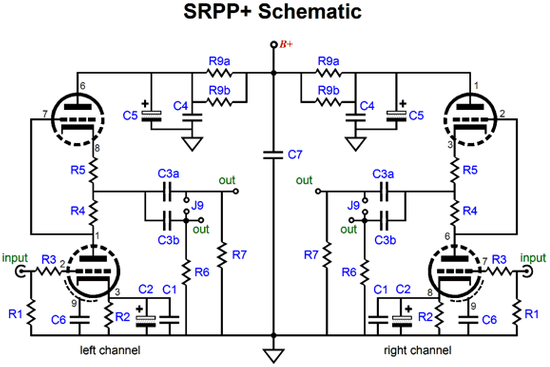GlassWare Audio Design
Thanks for Supporting the Tube CAD JournalNew Balancer PCB and Kit
SRPP Line-Stage Amplifier

In spite of its immense popularity and few circuit elements, few understand how the SRPP circuit works. The first step is to discern just what the SRPP’s function is. For example, is it a unity-gain buffer? A voltage amplifier? A phase splitter? An argument could be made for all three answers, but none would prove completely satisfying. Yes, the SRPP appears to encompass a cathode follower of sorts, making the unity-gain buffer answer seem at least partially right. And it does provide gain, making the voltage amplifier answer partially right. And it is capable of swinging positive and negative current swings into a load in excess of its idle current, making push-pull operation and, thus, making a portion of the phase splitter answer seem reasonable. So what is its primary function? The answer is that the SRPP is actually two elemental circuits, not one.
The SRPP is a compound circuit that holds a simple grounded-cathode amplifier that provides voltage gain and an impedance-multiplier that is neither a unity-gain buffer nor voltage amplifier. Two sub-circuits? The bottom triode is configured as a grounded-cathode amplifier that sees its plate loaded by a magnified load impedance provided by the top triode, which is configured as an impedance-multiplier. What is an impedance-multiplier? An impedance-multiplier is a circuit that effectively inflates the impedance presented by the load. An impedance doubler, as an example, doubles the effective impedance of the external load; for example, 300 ohms will be reflected as being 600 ohms. Thus, a 1mA current flow into the impedance-multiplier will not produce the 0.3V voltage drop across the 300-ohm load resistor, but instead 0.6V will develop across the resistor. So as far as the bottom tube in the SRPP is concerned, the 300-ohm load is now a 600-ohm load, which means that greater gain is now realizable by the grounded-cathode amplifier.
The SRPP is a compound circuit that holds a simple grounded-cathode amplifier that provides voltage gain and an impedance-multiplier that is neither a unity-gain buffer nor voltage amplifier. Two sub-circuits? The bottom triode is configured as a grounded-cathode amplifier that sees its plate loaded by a magnified load impedance provided by the top triode, which is configured as an impedance-multiplier. What is an impedance-multiplier? An impedance-multiplier is a circuit that effectively inflates the impedance presented by the load. An impedance doubler, as an example, doubles the effective impedance of the external load; for example, 300 ohms will be reflected as being 600 ohms. Thus, a 1mA current flow into the impedance-multiplier will not produce the 0.3V voltage drop across the 300-ohm load resistor, but instead 0.6V will develop across the resistor. So as far as the bottom tube in the SRPP is concerned, the 300-ohm load is now a 600-ohm load, which means that greater gain is now realizable by the grounded-cathode amplifier.
